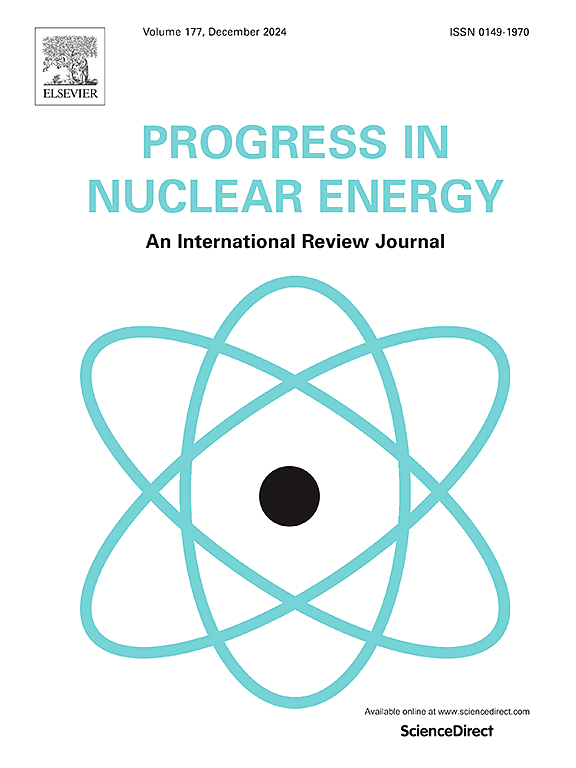精细子通道热工代码CUNLUN的开发与稳态验证
IF 3.3
3区 工程技术
Q1 NUCLEAR SCIENCE & TECHNOLOGY
引用次数: 0
摘要
根据压水堆冷却剂通道间流动特性,提出了一种利用精细子通道控制体积的堆芯子通道计算分析方法。基于分布阻力法,建立了混合叶片的三维动量源阻力模型。基于该方法,利用c++编程语言自主开发了压水堆堆芯热水力计算分析程序“CUNLUN”。采用Westinghouse 5 × 5棒束实验和OECD/NEA MATiS-H国际基准实验进行数值模拟。Westinghouse 5 × 5棒束实验的最大相对误差为6.73%,MATiS-H基准实验的模拟结果与实验数据吻合较好,表明该程序可以提高压水堆堆芯子通道内流动特性预测的精度。以计算流体力学(Computational Fluid Dynamics, CFD)模拟数据为基准数据,在112个比较点中,102个比较点的平均计算精度提高了74.21%,验证了基于分布阻力法的三维动量源混合叶片阻力模型对CUNLUN代码的适用性和有效性。本规范为压水堆燃料组件的热水力分析提供了有效的设计和研究工具,并为反应堆堆芯热水力分析程序的开发提供了宝贵的见解。本文章由计算机程序翻译,如有差异,请以英文原文为准。
Development and steady-state validation of the fine sub-channel thermal-hydraulic code CUNLUN
This paper, based on the flow characteristics of coolant between channels in a pressurized water reactor (PWR), proposes a reactor core sub-channel calculation and analysis method that utilizes fine sub-channel control volumes. A three-dimensional momentum source resistance model for mixing vanes was established based on the distributed resistance method. Using the C++ programming language, a PWR reactor core thermal-hydraulic calculation and analysis program called CUNLUN was independently developed based on this method. Numerical simulations were conducted using the Westinghouse 5 × 5 rod bundle experiment and the OECD/NEA MATiS-H international benchmark experiment. The maximum relative error for the Westinghouse 5 × 5 rod bundle experiment was 6.73%, and the simulation results for the MATiS-H benchmark experiment also agreed well with experimental data, demonstrating that this program can improve the accuracy of predicting flow characteristics within the sub-channels of a PWR reactor core. Additionally, Computational Fluid Dynamics (CFD) simulation data were used as benchmark data, and in 112 comparison points, the average calculation accuracy of 102 comparison points improved by 74.21%, verifying the applicability and validity of the three-dimensional momentum source resistance model for mixing vanes based on the distributed resistance method for the CUNLUN code. This code provides an effective design and research tool for thermal-hydraulic analysis of PWR fuel assemblies and offers valuable insights for the development of reactor core thermal-hydraulic analysis programs.
求助全文
通过发布文献求助,成功后即可免费获取论文全文。
去求助
来源期刊

Progress in Nuclear Energy
工程技术-核科学技术
CiteScore
5.30
自引率
14.80%
发文量
331
审稿时长
3.5 months
期刊介绍:
Progress in Nuclear Energy is an international review journal covering all aspects of nuclear science and engineering. In keeping with the maturity of nuclear power, articles on safety, siting and environmental problems are encouraged, as are those associated with economics and fuel management. However, basic physics and engineering will remain an important aspect of the editorial policy. Articles published are either of a review nature or present new material in more depth. They are aimed at researchers and technically-oriented managers working in the nuclear energy field.
Please note the following:
1) PNE seeks high quality research papers which are medium to long in length. Short research papers should be submitted to the journal Annals in Nuclear Energy.
2) PNE reserves the right to reject papers which are based solely on routine application of computer codes used to produce reactor designs or explain existing reactor phenomena. Such papers, although worthy, are best left as laboratory reports whereas Progress in Nuclear Energy seeks papers of originality, which are archival in nature, in the fields of mathematical and experimental nuclear technology, including fission, fusion (blanket physics, radiation damage), safety, materials aspects, economics, etc.
3) Review papers, which may occasionally be invited, are particularly sought by the journal in these fields.
 求助内容:
求助内容: 应助结果提醒方式:
应助结果提醒方式:


